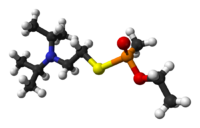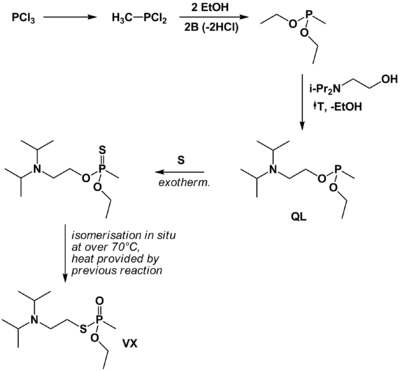Difference between revisions of "VX (nerve agent)" - New World Encyclopedia
Rick Swarts (talk | contribs) |
Rick Swarts (talk | contribs) |
||
| Line 113: | Line 113: | ||
<references/> | <references/> | ||
| − | Centers for Disease Control and Prevention (CDC). | + | Centers for Disease Control and Prevention (CDC). 2003. |
http://www.bt.cdc.gov/agent/vx/basics/facts.asp Facts About VX | http://www.bt.cdc.gov/agent/vx/basics/facts.asp Facts About VX | ||
Revision as of 22:47, 26 January 2009
| VX (nerve agent) | |
|---|---|

| |

| |
| IUPAC name | Ethyl {[2-[di(propan- 2-yl) amino] ethylsulfanyl} methylphosphinate; S-[2- (diisopropylamino) ethyl]- O-ethyl methylphosphonothioate (non-IUPAC synonym) |
| Identifiers | |
| CAS number | [] |
| SMILES | O=P(C)(OCC)SCCN(C(C)C)C(C)C |
| Properties | |
| Molecular formula | C11H26NO2PS |
| Density | 1.00083 g/mL |
| Melting point |
-50 °C, 223 K, -58 °F |
| Boiling point |
298 °C, 571 K, 568 °F |
| Vapor pressure | 0.0007 mm Hg (0.0933256 Pa) at 25 °C |
| Hazards | |
| NFPA 704 |
|
| Flash point | 159 °C[1] |
| Except where noted otherwise, data are given for materials in their standard state (at 25 °C, 100 kPa) Infobox references | |
VX (S-[2-(diisopropylamino)ethyl]-O-ethyl methylphosphonothioate) is an extremely toxic substance whose only application is in chemical warfare as a nerve agent. As a chemical weapon, it is classified as a weapon of mass destruction by the United Nations in UN Resolution 687. The production and stockpiling of VX was outlawed by the Chemical Weapons Convention of 1993.
The VX nerve agent is the most well-known of the V-series of nerve agents and is considered an area denial weapon due to its physical properties.
Discovery
Dr. Ranajit Ghosh, a chemist at the Plant Protection Laboratories of Imperial Chemical Industries was investigating a class of organophosphate compounds (organophosphate esters of substituted aminoethanethiols). Like the earlier investigator of organophosphates, Dr. Schrader, Dr. Ghosh found that they were quite effective pesticides. In 1954, ICI put one of them on the market under the trade name Amiton. It was subsequently withdrawn, as it was too toxic for safe use. The toxicity did not go unnoticed, and samples of it had been sent to the British Armed Forces research facility at Porton Down for evaluation. After the evaluation was complete, several members of this class of compounds would become a new group of nerve agents, the V agents. The best known of these is probably VX, assigned the UK Rainbow Code Purple Possum, with the Russian V-Agent coming a close second (Amiton is largely forgotten as VG). This class of compounds is also sometimes known as Tammelin's esters, after Lars-Erik Tammelin of the Swedish Institute of Defense Research. Dr. Tammelin was also conducting research on this class of compounds in 1952, but for obvious reasons he did not publicize his work widely.
Chemical characteristics
With its high viscosity and low volatility, VX has the texture and feel of motor oil. This makes it especially dangerous, as it has a high persistence in the environment. It is odorless and tasteless, and can be distributed as a liquid or, through evaporation, into small amounts of vapor. It works as a nerve agent by blocking the function of the enzyme acetylcholinesterase. Normally, an electric nerve pulse would cause the release of acetylcholine over a synapse that would stimulate muscle contraction. The acetylcholine is then broken down to non-reactive substances (acetic acid and choline) by the acetylcholinesterase enzyme. If more muscle tension is needed the nerve must release more acetylcholine. VX blocks the action of acetylcholinesterase, thus resulting in sustained contractions of all the muscles in the body. Sustained contraction of the diaphragm muscle causes death by asphyxiation.
Synthesis
VX is produced via the "Transester Process". This entails a series of steps whereby phosphorus trichloride is methylated to produce methyl phosphonous dichloride. The resulting material is reacted with ethanol to form a diester. This is then transesterified with 'N,N'-diisopropylaminoethanol to produce the mixed phosphonite. Finally, this immediate precursor is reacted with sulfur to form VX.
 |
Transester process |
VX can also be delivered in binary chemical weapons which mix in-flight to form the agent prior to release. Binary VX is referred to as VX2,[2] and is created by mixing aO-(2-diisopropylaminoethyl) O'-ethyl methylphosphonite (Agent QL) with elemental sulfur (Agent NE) as is done in the Bigeye aerial chemical bomb. It may also be produced by mixing with sulfur compounds, as with the liquid dimethyl polysulfide mixture (Agent NM) in the cancelled XM-768 8-inch binary projectile program.[citation needed]
Solvolysis
Like other organophosphorus nerve agents, VX may be destroyed by reaction with strong nucleophiles such as pralidoxime. The reaction of VX with concentrated aqueous sodium hydroxide results in competing cleavage of the P-O and P-S esters, with P-S cleavage dominating. This is somewhat problematic, since the product of P-O bond cleavage (named EA 2192) remains toxic. In contrast, reaction with the anion of hydrogen peroxide (hydroperoxidolysis) leads to exclusive cleavage of the P-S bond.[3]
Biological effects
- Further information: Nerve agent biological effects and treatment
VX is the most toxic nerve agent ever synthesized for which activity has been independently confirmed,[4] although unsubstantiated claims that some of the Novichok agents developed by the former Soviet Union are up to eight times more potent than VX have yet to be proved or disproved.[citation needed] The median lethal dose (LD50) for humans is estimated to be about 10 milligrams through skin contact and the LCt50 for inhalation is estimated to be 30-50 mg•min/m³.[5]
Early symptoms of percutaneous exposure (skin contact) may be local muscular twitching or sweating at the area of exposure followed by nausea or vomiting. Some of the early symptoms of a VX vapor exposure to nerve agent may be rhinorrhea (runny nose) and/or tightness in the chest with shortness of breath (bronchial constriction). Miosis (pinpointing of the pupils) may be an early sign of agent exposure but is not usually used as the only indicator of exposure.[6]
Treatment
Primary consideration should be given to removal of the liquid agent from the skin before removal of the individual to an uncontaminated area or atmosphere. After removal from the contaminated area, the casualty will be decontaminated by washing the contaminated areas with household bleach and flushing with clean water. After decontamination, the contaminated clothing is removed and skin contamination washed away. If possible, decontamination is completed before the casualty is taken for further medical treatment.
An individual who has received a known nerve-agent exposure or who exhibits definite signs or symptoms of nerve-agent exposure should immediately have the nerve agent antidote drugs atropine, pralidoxime (2-PAM), and diazepam injected. In several nations the nerve agent antidotes are issued for military personnel in the form of an autoinjector such as the United States military Mark I NAAK.[6]
Atropine works by binding and blocking a subset of acetylcholine receptors (known as muscarinic acetylcholine receptor, mAchR), so that the build up of acetylcholine produced by loss of the acetylcholinesterase function can no longer affect their target. The injection of pralidoxime regenerates bound acetylcholinesterase.
History
- For an in-depth discussion, see main article on nerve agent history
The chemists Ranajit Ghosh and J.F. Newman discovered the V-series nerve agents at ICI in 1952, patenting diethyl S- 2- diethylaminoethyl phosphono- thioate (VG) in November, 1952. Further commercial research on similar compounds ceased in 1955 when its lethality to humans was discovered. Information on the substance was passed to Porton Down in 1954 and research there led to VX within a year. This was traded to the United States as the British passed over VX in favour of continuing with sarin as the UK chemical weapon of choice, the reasoning behind the decision is unclear, although the recent completion of a sarin production facility at Nancekuke may have played a part.
The US then went into production of large amounts of VX in 1961 at Newport Chemical Depot.
Iraq under Saddam Hussein admitted to UNSCOM that it had researched VX, but had failed to weaponize the agent due to production failure. After U.S. and allied forces had invaded Iraq, no proof of weaponized VX was found. [1] Subsequent investigation after the 2003 Invasion of Iraq indicates that Iraq had indeed weaponized VX in 1988, and had dropped three VX-filled bombs on Iran. [2]
In December 1994 and January 1995, Masami Tsuchiya of AUM Shinrikyo synthesized 100 to 200 g of VX which was used to attack three persons. Two persons were injured and one 28-year-old man died, who is believed to be the only victim of VX ever documented in the world.[7] The VX victim, whom Shoko Asahara had suspected as a spy, was attacked at 7:00 am on December 12, 1994 on the street in Osaka by Tomomitsu Niimi and another AUM member, who sprinkled the nerve agent on his neck. He chased them for about 100 yards before collapsing, dying 10 days later without ever coming out of a deep coma. Doctors in the hospital suspected at the time he had been poisoned with an organophosphate pesticide. But the cause of death was pinned down only after cult members arrested for the subway attack confessed to the killing. Ethyl methylphosphonate, methylphosphonic acid and diisopropyl-2-(methylthio)ethylamine were later found from the body of the victim. Unlike the cases for sarin (Matsumoto incident and Sarin gas attack on the Tokyo subway), VX was not used for mass murder.
The only countries known to possess VX are the United States and Russia.[4] However, under Saddam Hussein's regime, Iraq was suspected of buying VX;[4] a Sudanese pharmaceutical facility was bombed by the U.S. in 1998 following allegations that it in some way used VX and that the origin of the agent was associated with both Iraq and Al Qaeda.[8] The chemical in question was later identified as O-ethyl hydrogen methylphosphonothioate (EMPTA), used to treat seeds and turf grasses.[9]
US VX stockpile elimination
Template:Cleanup In the late 1960s, the US canceled its chemical weapons programs and began the destruction of its stockpiles of agents by a variety of methods. Early disposal included the US Army's CHASE (Cut Holes And Sink 'Em) program, in which old ships were filled with chemical weapons stockpiles and then scuttled. CHASE 8[citation needed] was conducted on June 15, 1967, in which the S.S. Cpl. Eric G. Gibson was filled with 7,380 VX rockets and scuttled in 7,200 feet of water, off the coast of Atlantic City, New Jersey.
- Johnston Atoll Chemical Agent Disposal System in the North Pacific completed their VX stockpile destruction in 2000.
- Incineration was used for VX stockpile destruction starting in 1990
- Newport Chemical Depot completed their VX stockpile destruction in August, 2008.[10]
- Newport began VX stockpile elimination using chemical neutralization in 2005. VX is hydrolyzed to much less toxic byproducts by using concentrated caustic solution, and the resulting waste is then shipped off-site for further processing. Technical and political issues regarding this secondary byproduct resulted in some delays but most of Newport's stockpile was eliminated in 2007.
- Pine Bluff Arsenal completed their VX stockpile destruction using incineration in June, 2008.
- Umatilla Chemical Depot completed their VX stockpile destruction using incineration in November, 2008.
- Anniston Army Depot completed their VX stockpile destruction using incineration in December, 2008.
Worldwide VX stockpile elimination
Worldwide, VX disposal continues, since 1997 under the mandate of the Chemical Weapons Convention. The US is providing support for Russian destruction activities. A new destruction plant, being built for an amount of 140 million € and paid for by Germany, is to open at Potshep, region Brjansk, in 2009.
See also
- Dugway sheep incident
- The Rock (film)
ReferencesISBN links support NWE through referral fees
- ↑ MSDS: Nerve Agent (VX). Edgewood Chemical Biological Center (ECBC), Department of the Army (22 December 2000). Retrieved 2007-10-25.
- ↑ Ellison, D. Hank. Handbook of Chemical and Biological Agents, (Google Books), CRC Press, New York: 2007, p. 47, (ISBN 0849314348).
- ↑ Yang, Yu-Chu, "Chemical Detoxification of Nerve Agent VX", Acc. Chem. Res., p. 109-115..
- ↑ 4.0 4.1 4.2 VX. Council on Foreign Relations (2006-01). Retrieved 2007-03-27. Cite error: Invalid
<ref>tag; name "cfr" defined multiple times with different content - ↑ Federation of American Scientists :: Types of Chemical Weapons
- ↑ 6.0 6.1 US Army Toxic Chemical Agent Safety Standards (PDF). DA PAM 385-61. Section 7-8 Self/Buddy Aid Procedures. US Army. Retrieved 2007-12-15.
- ↑ Pamela Zurer, "Japanese cult used VX to slay member" Chemical and Engineering News 1998, Vol 76 (no. 35).
- ↑ Chomsky, Noam (October 2001). 9-11. Open Media.
- ↑ Coleman, Kim (2005). History of Chemical Warfare. Palmgrave MacMillan.
- ↑ http://www.cma.army.mil/fndocumentviewer.aspx?docid=003678571
Centers for Disease Control and Prevention (CDC). 2003. http://www.bt.cdc.gov/agent/vx/basics/facts.asp Facts About VX
Update by Karl Harrison
VX Gas (Molecule of the Month for June 1998)
http://www.3dchem.com/molecules.asp?ID=99
External links
- Oxford website on Nerve Agents
- Questions and Answers for VX
- CDC Facts About VX
- U.S. Army's Chemical Materials Agency (CMA)
- CBW Info
- National Academies: Health effects of VX
- DA PAM 385-61 US Army Toxic Chemical Agent Safety Standards
- Decommissioning Surplus VX - Article from NYTimes.com
| Agents of Chemical Warfare | ||
|---|---|---|
| Blood agents: | Cyanogen chloride (CK) – Hydrogen cyanide (AC) | |
| Blister agents: | Lewisite (L) – Sulfur mustard gas (HD, H, HT, HL, HQ) – Nitrogen mustard gas (HN1, HN2, HN3) | |
| Nerve agents: | G-Agents: Tabun (GA) – Sarin (GB) – Soman (GD) – Cyclosarin (GF) | V-Agents: VE – VG – VM – VX | |
| Pulmonary agents: | Chlorine – Chloropicrin (PS) – Phosgene (CG) – Diphosgene (DP) | |
| Incapacitating agents: | Agent 15 (BZ) – KOLOKOL-1 | |
| Riot control agents: | Pepper spray (OC) – CS gas – CN gas (mace) – CR gas | |
| |||||||||||||||||||||||
Credits
New World Encyclopedia writers and editors rewrote and completed the Wikipedia article in accordance with New World Encyclopedia standards. This article abides by terms of the Creative Commons CC-by-sa 3.0 License (CC-by-sa), which may be used and disseminated with proper attribution. Credit is due under the terms of this license that can reference both the New World Encyclopedia contributors and the selfless volunteer contributors of the Wikimedia Foundation. To cite this article click here for a list of acceptable citing formats.The history of earlier contributions by wikipedians is accessible to researchers here:
The history of this article since it was imported to New World Encyclopedia:
Note: Some restrictions may apply to use of individual images which are separately licensed.


